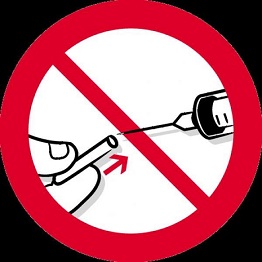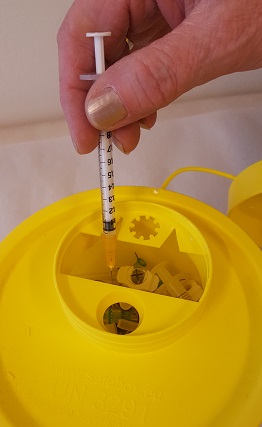Disposal of infectious waste - Kunnskapsbasen
Disposal of infectious waste
These guidelines describe handling and disposal of infectious waste. Each unit is responsible for handling its own infectious waste. Individuals handling infectious waste are obligated to familiarise themselves with procedures, guidelines and legislation.
Norsk versjon - Avhende smittefarlig avfall
Subject page about HSE | Pages labelled with waste
These guidelines do not apply for employees who are working in hospital facilities. Employees in hospital facilities should follow the guidelines at St. Olavs Hospital.
Useful overviews
- Price list (you have to be logged on to Innsida). Transport and empty packaging is included in the unit prices. To avoid running out of packaging: Order packaging together with collection of infectious waste.
- Overview of standard hazard labels, labels and packaging (in Norwegian) delivered from Norsk Gjenvinning AS. Other packaging can be delivered upon request (additional fees apply). See Contact.
Ordering waste collection
Order collection of infectious waste through the order system. If your unit has a collection agreement with the waste recipient, you do not have to order collection.
Fill in the following information under "Specification of goods/services":
Infectious waste
Specify quantity and type
UN no.: 3291
ADR danger classification: 6.2
EAL code: 18 01 02 (waste from activities where a veterinarian, or other animal health personnel, provides health aid to animals) or 18 01 03 (waste from primary health care, specialist health care and other medical activities.
Fill in the following under "Provider":
- Norsk Gjenvinning AS
Note that infectious waste should not be declared through avfallsdeklarering.no (in Norwegian). The reason for this is thatinfectious waste is not defined as hazardous waste. However, infectious waste is hazardous goods and must be delivered to an approved facility for destruction.
The driver who collects the waste will use the order sent through the order system as transport documentation. The unit also has a record of the infectious waste it has disposed of, through the records in the order system, cf. the documentation requirements in the Regulation of infectious healthcare waste § 8 (in Norwegian).
Labels and signs
- Infectious waste should always be disposed of in separate, yellow boxes.
- Cannulas/needles should not be "recapped", due to the risk of prick wounds.
- Put the lid on the box when it is full. NB: Do not fill the box to the point where you risk coming in contact with its contents.

Correct procedure for disposal of cannula/needle in yellow box for infectious waste:

- Yellow boxes are placed in a large, yellow container for infectious waste (50/60ltr). The container should be labelled before delivery.
- Check the correct category on the label.State the waste's unit of origin in the field "Institution – Department".
- Make sure that the lid is properly secured.
Large, yellow container for infectious waste:

Ordering packaging
Packaging can be ordered through the order system. Contact the waste recipient with any questions related to packaging. See Contact. Appropriate packaging can be ordered in several different sizes, e.g. a small container for cannulas and larger containers for larger quantities of waste, or for collection of several smaller containers with cannulas (see illustrations above). Assess how much packaging you should keep in storage to avoid running out while waiting for waste collection. Feel free to make an arrangement with the waste recipient, where they deliver the same number of containers they collect.
Waste to be disposed of as infectious waste
Waste from medical or veterinary treatments and/or medical or veterinary teaching, research and diagnostics, which contains viable microorganisms or toxins that can cause disease in humans or other living organisms.
- Tissue samples, cells, blood, urine, genetically modified organisms and similar things that might represent danger of infection or other hazards.
- Objects that contain biological material, antibiotics and/or cytotoxicity; sharp objects like needles, scalpels, disposable tubes, disposable inoculating needles, etc.
- Pathological waste; Body parts/organs/tissue from animals and humans.
- Waste from airborne infection isolation wards.
Even if the waste described above does not necessarily constitute a risk of infection, NTNU includes the waste in this fraction by agreement with Norsk Gjenvinning AS. The waste is burned.
Organic solvents, explosive or highly reactive chemicals, toxic inorganic compounds and heavy metals (mercury, cadmium, lead, etc.) must not be mixed with infectious waste!
If you cannot avoid including small amounts of organic solvents or toxic inorganic compounds, the waste must be assessed for fire hazard, danger of hazardous evaporation and boundary values, cf. the waste regulation, chapter 11, appendix 2 (in Norwegian). There are no given boundary values for inflammable and oxidising substances. Handling and disposal of such waste must be clarified with the waste recipient (in Norwegian).
Help
- Laboratory and workshop handbook (in Norwegian)
- Instructions on biological factors (in Norwegian) – the Norwegian Labour Inspection Authority
NTNU regulations
- Working with biological agents
- Working with human materials
- Emergency plans
- HSE process
- Risk assessments
- Room cards
- Coordination agreement
Legislation
- ADR/RID Regulation of land-carriage of hazardous goods (in Norwegian)
- The Working Environment Act (in Norwegian)
- The Workplace Regulation (in Norwegian)
- The Waste Regulation (in Norwegian)
- Regulation of organisation, management and partaking (in Norwegian)
- Regulation of infectious healthcare waste (in Norwegian)
- Regulation of the performance of work (in Norwegian)
- The Pollution Act (in Norwegian)
- Environmental Information Act (in Norwegian)
Contact
- Questions about handling and disposal of hazardous and infectious waste, incl. sorting, packaging, marking and declaration of hazardous waste. All orders, including packaging and label orders etc., are made through the order system:
- Norsk Gjenvinning AS, contact person Patrick Fløistad; patrick.floistad@ngn.no, phone: 92600031 08:00–16:00, all business days).
- NTNU safety adviser:
- Questions about pricing, terms, invoices, nonconformities and quality:
- The HSE coordinator at your unit (Questions about infectious waste at your unit)
- Arve Johansen, HSE adviser, HSE Division (Other questions)
- Ann Kristin Sjaastad, Occupational Hygienist, HSE Division (Other questions)
- Safety Adviser (Questions about regulations concerning transport of infectious waste)
Approval/signature
Approved by the Director of HSE – 4th february 2020 – HMSRV1801
Edited 27.08.2020
